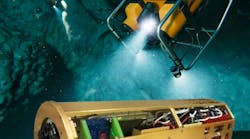By J.R. Wilson
Precision-guided munitions have become synonymous with the U.S. military in the past two decades, with each new advance in technology increasing the ability to hit a specific target with a single shot while greatly reducing the danger of collateral damage.
Today, the Defense Advanced Research Projects Agency (DARPA), individual service research labs, contractors, and academia continue to advance the systems, subsystems, and components necessary to bring even greater precision to the battlefield. That already has taken warfare from carpet-bombing large areas surrounding an actual target to hitting a specific building to hitting a specific room in that building. In the near-term, guided bullets and precise guidance of other small munitions will make it possible to hit a specific target within that room.
Other advances now coming out of the labs will take precision strike to an entirely new level. Heading that list are directed-energy weapons, seemingly precise by their very nature, but actually relying on many of the same technologies employed by precision-guided munitions to ensure they are on target.
“The pointing stability of a directed-energy weapon is actually a high-navigation performance,” says U.S. Air Force Lt. Col. Jay Lowell, a program manager in DARPA’s Defense Sciences Office. “The pointing stability has to be phenomenal over any appreciable distance to hit what you want to hit. [Precision Inertial Navigation Systems, one of his programs] is the technology that gives you the angular stability to do that in absolute space over a wide range.”
Some directed-energy weapons already are being demonstrated, such as the Air Force’s Airborne Laser (ABL) to shoot down missiles and Advanced Tactical Laser (ATL) to attack mobile ground targets. Both employ chemical lasers, which have been the only systems capable of generating sufficient power on target within size and weight limitations for an aircraft.
The future of directed-energy in combat will require systems far lighter, smaller, more powerful and less logistics-intense than today’s chemical lasers. Options include developing a liquid laser that meets the requirements or moving to solid-state lasers.
Two current programs in this arena are the Joint High Power Solid State Laser (JHPSSL), a three-year effort to produce a lab-based, 100-kilowatt technology demonstrator, funded by the High Energy Laser Joint Technology Office and the Army, and the High Energy Liquid Laser Area Defense System (HELLADS), a multi-phase DARPA program with an end goal of building and demonstrating a 150-kilowatt weapons system. Northrop Grumman Aerospace Systems in Redondo Beach, Calif., and Textron Defense Systems in Wilmington, Mass., have contracts for JHPSSL, while Textron and General Atomics in San Diego are competing on HELLADS.
“We’re about halfway there right there right now (on JHPSSL), having begun about three years ago,” says Dr. John Boness, Textron’s vice president for directed-energy Weapons. “On HELLADS, we are approaching the demonstration of a unit cell, which is a one-third (50-kilowatt) element of the final system. That is scheduled by the end of 2009.”
DARPA’s announced plans call for a down-select to one contractor at the end of Phase I and a quick transition to phase 2—a two-year effort to build two additional 50-kilowatt modules, then combining them to demonstrate a 150-kilowatt-level system. If successful, at that point DARPA would transition HELLADS to the military to field test on an aircraft.
“To really put them into the field, in combat, would be the next step, perhaps out in the seven- to ten-year range,” Boness adds. “In smaller power ranges, if you can convince the military they have a battlefield utility, they could be available more quickly.”
While Star Trek-style hand weapons are unlikely in the foreseeable future, those at the forefront of directed-energy development believe the technology will become as important to future military operations as precision-guided munitions are today.
“They are a game changer,” Boness explains. “You can use a very small spot size on target, perhaps tens of centimeters, depending on the range, and deliver energy into a very tight dimension compared to even a small munition. So the small collateral benefit is considered very attractive,” Boness concludes. “Because they move at the speed of light, you have a practically instantaneous engagement and can deal with moving targets with immediate impact. And after it’s over, there is no hazardous ordnance trail.
“We don’t see directed-energy weapons as replacements for precision-guided munitions,” Boness says. “They have a niche and, in general, we see them as being more complementary. Of course, there are circumstances where directed-energy comes more into its own.”
More Military & Aerospace Electronics Current Issue Articles
More Military & Aerospace Electronics Archives Issue Articles


